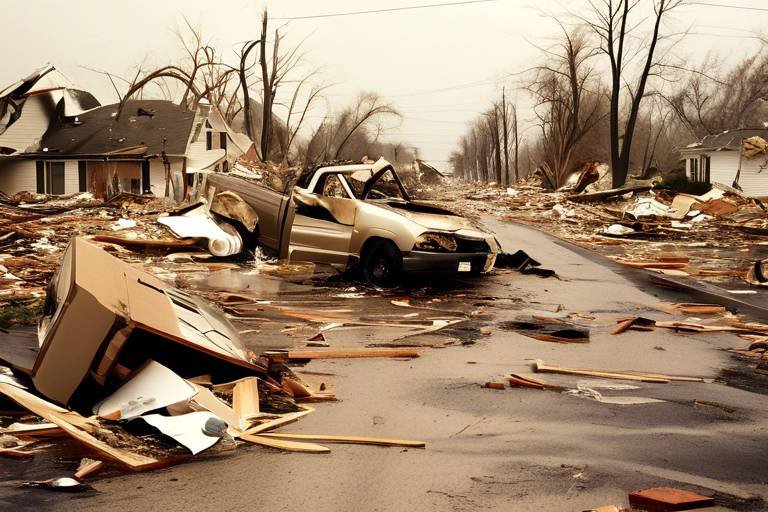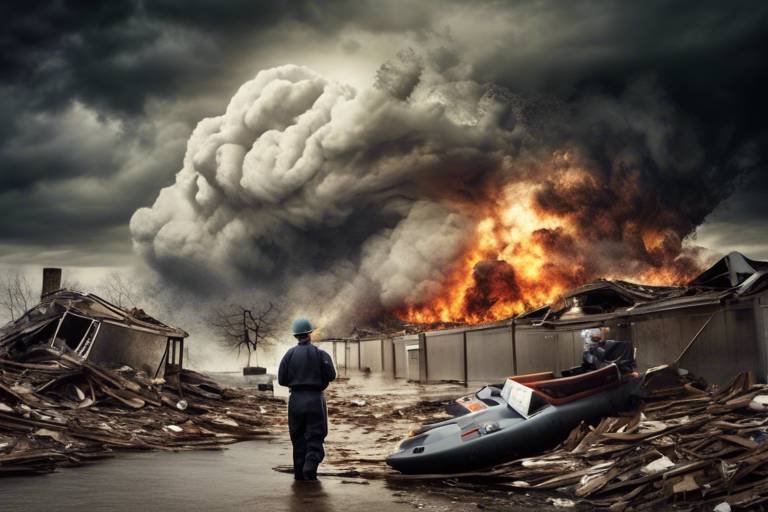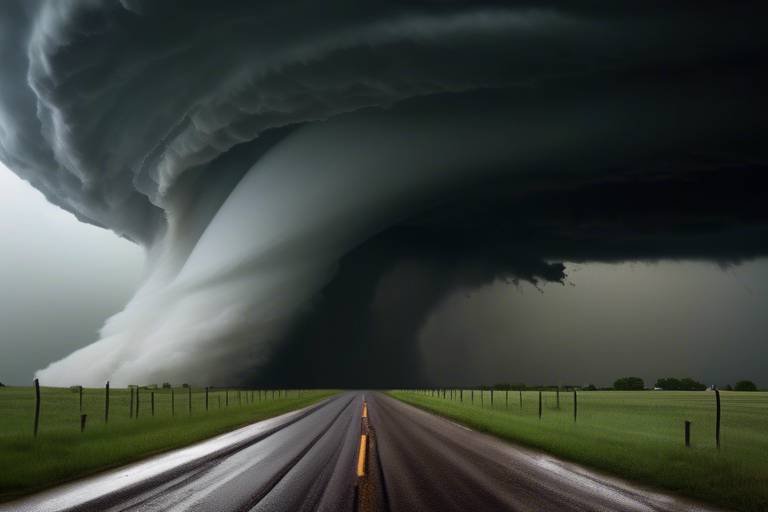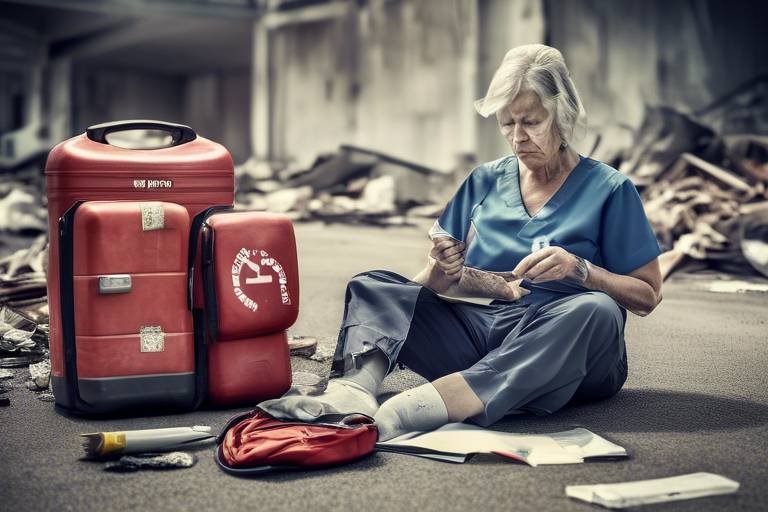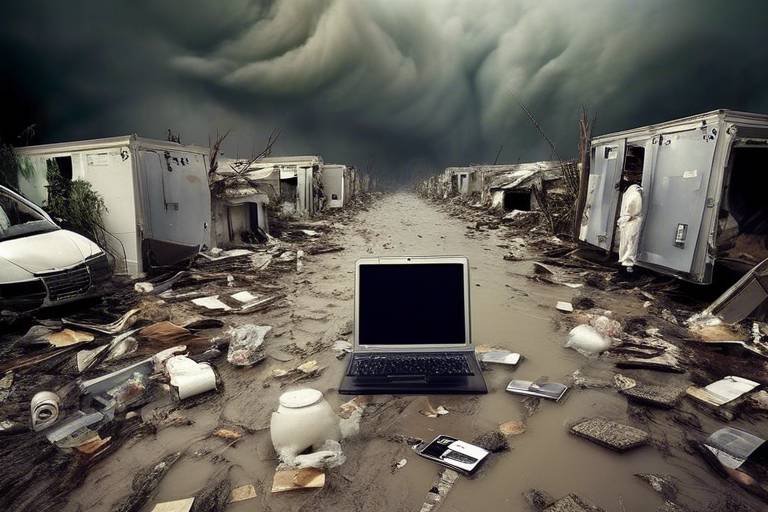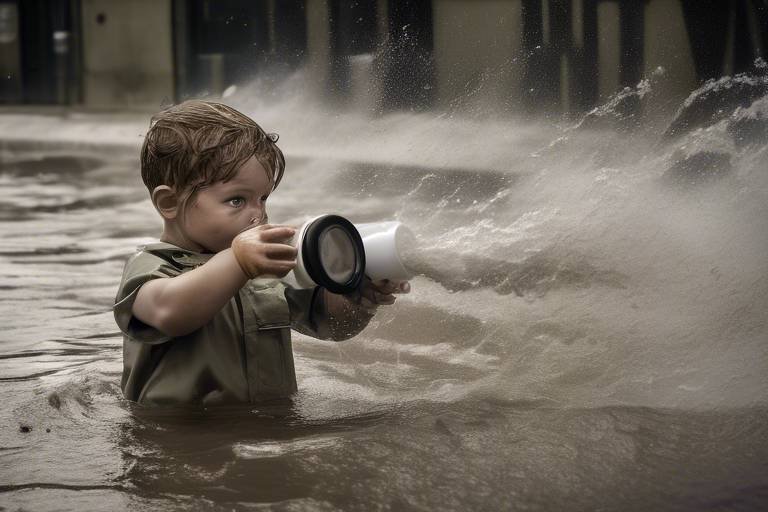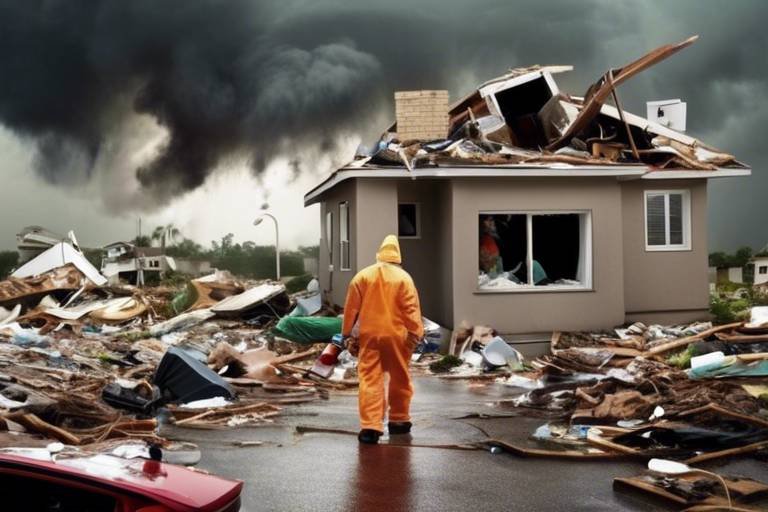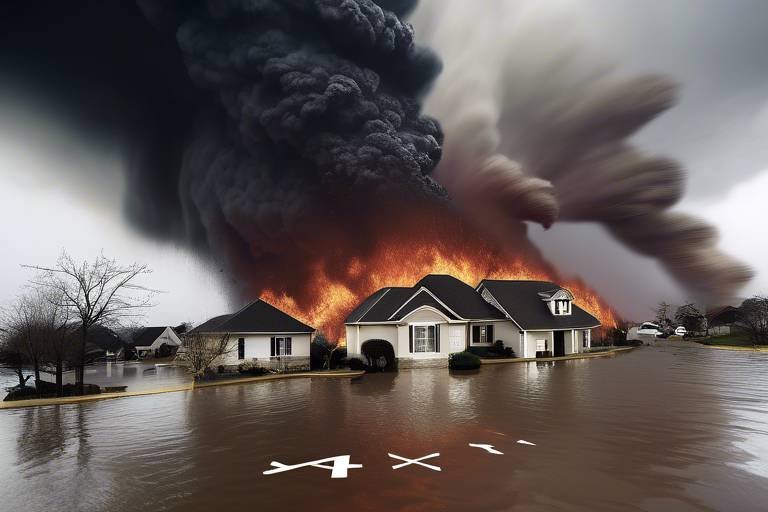Aftermath of Disasters - Essential Cleanup Tips
Disasters can strike without warning, leaving chaos and destruction in their wake. Whether it’s a natural calamity like a hurricane or an unexpected incident such as a fire, the aftermath can be overwhelming. The cleanup process is not just about restoring order; it’s about ensuring safety and preventing further damage. In this article, we’ll delve into effective strategies to manage the cleanup process after a disaster, helping you navigate the complexities of recovery while prioritizing safety and efficiency.
The first step in disaster cleanup is to assess the damage. This is crucial because understanding the extent of the destruction will inform your next steps. Start by evaluating the structural integrity of your home or the affected area. Look for visible signs of damage such as cracks in walls, sagging roofs, or broken windows. If it’s safe to do so, take a closer look at the foundation and any supporting structures. Remember, some damage may not be immediately visible, so proceed with caution.
In addition to structural assessments, it's essential to identify hazardous materials. Floodwaters can carry contaminants, while fire damage can leave behind toxic residues. If you suspect the presence of hazardous substances, it’s best to consult professionals who specialize in hazardous material cleanup. They can help ensure that the environment is safe for you and your loved ones.
Prioritizing safety during the cleanup process is vital. You may be eager to get started, but rushing in without proper precautions can lead to injuries or health risks. First and foremost, equip yourself with the right protective gear. This includes gloves, masks, and goggles to shield yourself from harmful substances. It’s like gearing up for a battle; you wouldn’t go in without armor, right?
Choosing appropriate protective gear is crucial for disaster cleanup. Here are some essential items you should consider:
- Gloves: Opt for heavy-duty gloves that can protect your hands from sharp objects and hazardous materials.
- Masks: A good mask will filter out dust, mold spores, and other airborne contaminants.
- Goggles: Protect your eyes from debris and harmful substances that may be present during cleanup.
By ensuring you have the right gear, you can significantly reduce the risk of injury and health issues.
Having a well-stocked first aid kit on hand during cleanup is essential. You never know when an accident might happen, and being prepared can make all the difference. Here are some necessary items to include:
- Adhesive bandages
- Antiseptic wipes
- Gauze pads and tape
- Scissors
- Pain relievers
Make sure everyone involved in the cleanup knows where the first aid kit is located and how to use its contents. It’s always better to be safe than sorry!
Keeping a list of emergency contacts readily available can be lifesaving. This should include numbers for:
- Local emergency services
- Utility companies
- Hazardous material disposal services
Having these contacts at your fingertips can expedite assistance when you need it most. Remember, time is of the essence in emergencies!
Identifying and safely handling hazardous materials is crucial in disaster cleanup. Common hazardous materials include chemicals, asbestos, and mold. Each of these requires specific handling and disposal methods to ensure safety. For instance, mold can pose serious health risks, so it’s best to consult professionals if you encounter it in large quantities. Always prioritize your health and safety when dealing with such materials.
A well-structured cleanup plan can enhance efficiency. Start by organizing teams and assigning tasks based on each person’s strengths. Create a timeline to keep everyone on track and ensure that no area is overlooked. Think of it like a well-choreographed dance; each person has a role to play, and when everyone moves in sync, the cleanup becomes much more manageable.
Effective team coordination is essential for a successful cleanup. Regular check-ins can help maintain communication among team members. Consider using tools like group messaging apps to keep everyone informed and engaged. When everyone is on the same page, you can maximize productivity and tackle challenges as they arise.
Managing resources effectively can streamline the cleanup process. Allocate tools, supplies, and manpower based on the most pressing tasks. For example, if a particular area is heavily affected, ensure that enough hands are on deck to address it quickly. By being strategic about resource allocation, you can tackle the cleanup more efficiently.
Once the initial cleanup is complete, restoration begins. This is where you can start to breathe a little easier, knowing that the worst is over. However, restoration is just as important as cleanup. It involves repairs, sanitation, and taking steps to prevent future damage. Think of it as rebuilding your home’s spirit after a storm.
Addressing repairs and renovations after a disaster is crucial for restoring functionality. Start by prioritizing repairs based on urgency and safety. For example, if there are structural issues, those should be handled first. Working with professionals can also ensure that repairs are done correctly and efficiently. It’s like hiring a skilled chef to prepare a gourmet meal—you want the best results!
Implementing preventive measures can mitigate future disaster impacts. Consider reinforcing structures, installing sump pumps, or investing in flood barriers. Being proactive can save you time, money, and stress in the long run. Remember, an ounce of prevention is worth a pound of cure!
Q: What should I do first after a disaster?
A: Assess the damage and ensure the area is safe before starting cleanup.
Q: How can I protect myself during cleanup?
A: Wear appropriate protective gear and keep a first aid kit handy.
Q: When should I call professionals?
A: If you encounter hazardous materials or significant structural damage, it’s best to consult professionals.

Assessing the Damage
When disaster strikes, the aftermath can feel overwhelming, but understanding the extent of the damage is your first step toward recovery. Picture this: you step outside your home, and what once was a familiar landscape is now a chaotic mess. The first thing you need to do is assess the situation carefully. This means taking a thorough look at both the interior and exterior of your property. Are there visible cracks in the walls? Is the roof intact? These questions are crucial in determining whether your home is safe to enter.
Start by evaluating the structural integrity of your home. Look for signs of sagging ceilings, uneven floors, or doors that won’t close properly. These could indicate that your house has sustained serious damage. If you notice any of these issues, it’s best to consult a professional before proceeding further. Remember, safety first! If you’re unsure about the stability of your home, it’s wise to wait for an expert’s opinion.
Next, you’ll want to identify any hazardous materials that may be present. Disasters can expose you to a range of dangerous substances, from mold spores to asbestos. If you see any debris that looks suspicious or if you smell something off, it’s important to proceed with caution. The following are common hazardous materials to watch out for:
- Mold: Can grow in damp areas and pose serious health risks.
- Asbestos: Often found in older buildings; disturbing it can release harmful fibers.
- Chemicals: Any spilled chemicals or fuels should be treated as hazardous.
Documenting the damage is another critical step. Take pictures and make notes of what you see; this information will be invaluable for insurance claims and future repairs. A well-documented assessment not only helps you keep track of what needs to be done but also serves as proof of the damage incurred. You might consider creating a simple damage assessment table to organize your findings:
| Area | Type of Damage | Notes |
|---|---|---|
| Living Room | Water Damage | Ceiling stains, warped flooring |
| Kitchen | Structural Damage | Cracks in the walls |
| Basement | Mold Growth | Visible mold on walls |
In conclusion, assessing the damage is more than just a checklist; it’s about understanding the full scope of what you’re dealing with. Taking the time to evaluate your property thoroughly will not only ensure your safety but also set the stage for an effective cleanup and restoration process. Remember, the sooner you assess the damage, the sooner you can begin to reclaim your space and restore normalcy to your life.
Q: What should I do first after a disaster?
A: The first step is to assess the damage carefully while ensuring your safety. Look for structural issues and hazardous materials before entering your home.
Q: How can I identify hazardous materials?
A: Be on the lookout for mold, asbestos, and any spilled chemicals. If you’re unsure, it’s best to consult a professional.
Q: Is it necessary to document the damage?
A: Yes, documenting the damage is crucial for insurance claims and helps you keep track of necessary repairs.

Safety Precautions
When it comes to disaster cleanup, prioritizing safety is not just a good practice; it's absolutely essential. The aftermath of a disaster can be chaotic, with debris scattered everywhere and potential hazards lurking in unexpected places. Imagine stepping into a room filled with broken glass, sharp metal, or even hazardous chemicals. It’s crucial to approach the cleanup with a safety-first mindset to protect yourself and others. So, what are the key safety measures you should take? Let’s dive into the essentials.
First and foremost, the right protective gear can make all the difference. Think of it as your armor against the unknown—gloves, masks, goggles, and sturdy boots are your first line of defense. Each piece of gear serves a specific purpose. For instance, gloves protect your hands from cuts and chemical burns, while masks can shield your lungs from dust and toxic fumes. It’s like preparing for a battle; you wouldn’t go in without your gear, right? Here’s a quick rundown of essential protective equipment:
| Protective Gear | Purpose |
|---|---|
| Gloves | Protect hands from cuts and chemicals |
| Masks | Filter harmful dust and fumes |
| Goggles | Shield eyes from debris and chemicals |
| Sturdy Boots | Protect feet from sharp objects and provide traction |
In addition to protective gear, having a well-stocked first aid kit on hand is crucial. You never know when a minor injury might occur, and being prepared can save you a lot of trouble. Your first aid kit should include essentials like band-aids, antiseptic wipes, gauze, and even a pair of scissors. Think of it as your safety net; having it ready can turn a potential crisis into a manageable situation.
Moreover, it’s vital to keep a list of emergency contacts readily available. This list should include numbers for local medical facilities, utility companies, and hazardous material disposal services. In moments of panic, knowing who to call can be a lifesaver. Imagine trying to remember a phone number while dealing with a crisis—stressful, right? Having these contacts at your fingertips can streamline the process and ensure that help is just a call away.
Lastly, let’s talk about hazardous materials. After a disaster, you might encounter substances that can pose serious health risks, such as asbestos, lead, or chemicals from damaged containers. Identifying these materials is crucial for your safety. When dealing with hazardous materials, it’s best to consult professionals who are trained to handle such situations. They have the knowledge and equipment to dispose of these materials safely, protecting not just you but also the environment.
In conclusion, the cleanup process after a disaster can be overwhelming, but with the right safety precautions in place, you can tackle it effectively. Remember, your safety should always come first. Equip yourself with the necessary protective gear, keep a first aid kit handy, have emergency contacts ready, and be cautious of hazardous materials. By doing so, you’ll not only protect yourself but also create a safer environment for everyone involved in the cleanup.
- What should I wear for disaster cleanup? It's best to wear sturdy boots, gloves, a mask, and goggles to protect yourself from debris and harmful substances.
- How do I know if a material is hazardous? If you suspect a material might be hazardous, it's wise to consult a professional or local environmental agency for guidance.
- What should I include in my first aid kit? Your first aid kit should contain band-aids, antiseptic wipes, gauze, scissors, and any personal medications you might need.
- Who should I contact in case of an emergency? Keep a list of local medical facilities, utility companies, and hazardous material disposal services handy for emergencies.

Protective Gear
When diving into the chaos of disaster cleanup, one of the most critical aspects to consider is your safety. Just like a knight wouldn’t go into battle without their armor, you shouldn’t tackle cleanup without the right . This gear serves as your first line of defense against various hazards you might encounter, from sharp debris to harmful chemicals. So, what exactly do you need to gear up for this challenging task?
First and foremost, gloves are a must-have. They protect your hands from cuts, scrapes, and exposure to hazardous materials. Opt for heavy-duty gloves that can withstand rough conditions; think of them as your protective shield. Next up, you need masks. Dust, mold, and other airborne particles can pose serious health risks, so a good-quality mask will help filter out harmful substances. You might feel a bit like an astronaut, but your lungs will thank you!
Don’t forget about goggles. These are essential for keeping your eyes safe from flying debris and chemicals. Imagine trying to clean up a storm-damaged area without being able to see properly—yikes! Eye protection is not just a suggestion; it’s a necessity. And if you're dealing with particularly hazardous materials, consider a full-face respirator. It may look intense, but it provides comprehensive protection, ensuring you can breathe easy while working hard.
In addition to these basics, wearing sturdy boots with non-slip soles is crucial. You want to ensure that your footing is secure, especially if you're working in wet or unstable conditions. Think of your boots as your grounding force, helping you navigate through the rubble without slipping and falling. And let’s not overlook long-sleeved clothing. Protective clothing can shield your skin from cuts and scrapes, and it also helps to guard against insect bites or exposure to irritants.
Finally, remember that isn’t just about individual items; it’s about how they work together to keep you safe. Always inspect your gear before use, ensuring everything is in good condition. If something is damaged, replace it. Your safety is paramount, and being well-prepared can make all the difference in your cleanup efforts. So, as you prepare for the task ahead, arm yourself with the right protective gear and tackle that cleanup like the hero you are!

First Aid Kits
When diving into the chaos of disaster cleanup, having a well-stocked first aid kit is like having a lifeline. You never know when a minor scrape or bruise could turn into a bigger issue if not treated promptly. Imagine this: you're knee-deep in debris, and suddenly, someone cuts their hand on a sharp object. Without a first aid kit, a small problem can escalate into a major setback. So, what should you include in your kit to ensure you're prepared for those unexpected moments?
First and foremost, your first aid kit should contain the essentials. Think of it as your mini-emergency room, ready to tackle minor injuries on the spot. Here’s a quick rundown of the must-have items:
- Adhesive Bandages: For those inevitable cuts and scrapes.
- Antiseptic Wipes: To clean wounds and prevent infection.
- Gauze and Tape: For larger wounds that need more protection.
- Antibiotic Ointment: To apply on cuts to keep them safe from bacteria.
- Instant Cold Packs: Perfect for reducing swelling or pain.
- Scissors and Tweezers: Handy for cutting tape or removing splinters.
- Pain Relievers: Over-the-counter medications like ibuprofen or acetaminophen can help manage discomfort.
But here's the kicker: it’s not just about having these items; it’s about knowing how to use them effectively. Take the time to familiarize yourself with basic first aid techniques. You don’t want to be fumbling around in a crisis, right? Knowing how to properly clean a wound or apply a bandage can make all the difference.
Additionally, consider customizing your first aid kit based on specific needs. For example, if you or someone in your group has allergies, including an epinephrine auto-injector could be a lifesaver. It's also wise to include any personal medications and a list of emergency contacts. This way, if someone needs immediate assistance, you can act quickly and efficiently.
Lastly, don’t forget to regularly check and replenish your first aid kit. Just like your car, it needs maintenance. Make it a habit to inspect the kit every few months to ensure that items are not expired and that you have everything you need. This simple step can save precious time and effort when you need it most.

Emergency Contacts
When disaster strikes, having a reliable list of can make all the difference between chaos and calm. Imagine being in the midst of a storm, debris flying around, and you suddenly realize you need help. Who do you call? This is why it's essential to have a well-organized list of contacts readily available. Start by including local emergency services, such as police, fire, and medical assistance. It's also wise to have contacts for utility companies, especially if your home sustains damage to gas or electrical lines. Additionally, don't forget to include contacts for family members and friends who can provide support or shelter during these challenging times.
Consider creating a table to organize this information clearly. Here’s a simple layout you might find helpful:
| Type of Contact | Name | Phone Number | Notes |
|---|---|---|---|
| Emergency Services | Police | 911 | For immediate assistance |
| Emergency Services | Fire Department | 911 | For fire-related emergencies |
| Emergency Services | Medical Assistance | 911 | For medical emergencies |
| Utility Company | Electricity | (Your local number) | Report outages or hazards |
| Utility Company | Gas | (Your local number) | Report leaks or issues |
| Family/Friends | (Name) | (Phone Number) | Emergency contact for support |
Keep this list in a few accessible places: on your fridge, in a digital format on your phone, and even in your wallet. It’s not just a good idea; it’s a lifeline that could save you or someone else in a moment of need. Remember, during a disaster, communication can become chaotic, so having these contacts at your fingertips ensures you can quickly reach out for help when needed.
Lastly, don’t forget to periodically review and update your emergency contact list. People move, change jobs, or may no longer be reachable, so keeping this list current is vital. Think of it as a safety net—the more robust it is, the better prepared you’ll be when disaster strikes.

Hazardous Materials
When dealing with the aftermath of a disaster, one of the most critical aspects to focus on is the identification and safe handling of . These substances can pose significant risks not only to your health but also to the environment. From chemicals to biological agents, understanding what you're dealing with is essential for a safe cleanup process. Imagine stepping into a scene where you think you're just cleaning up debris, but hidden within that rubble could be toxic substances like asbestos or mold spores. That’s why a thorough assessment is key.
First, it’s vital to recognize common hazardous materials that may be present in disaster-affected areas. For instance, if your area experienced flooding, you might encounter contaminated water, which could harbor bacteria and viruses. Additionally, structural damage could expose lead paint or asbestos, especially in older buildings. Understanding these risks can help you prepare adequately. Here’s a brief rundown of hazardous materials you may encounter:
- Asbestos: Often found in older buildings, this material can cause serious respiratory issues if disturbed.
- Lead: Common in paint and pipes, lead exposure can be harmful, especially to children.
- Mold: A frequent issue after water damage, mold can lead to various health problems.
- Chemicals: Cleaning agents, pesticides, and other chemicals may become hazardous when mixed or improperly stored.
Once you’ve identified these hazardous materials, the next step is to handle them safely. Always wear appropriate protective gear, such as gloves and masks, to minimize exposure. If you suspect the presence of asbestos or lead, it’s best to contact professionals who are trained in safe removal practices. Don’t take unnecessary risks; your health and safety should always come first.
Furthermore, proper disposal of hazardous materials is crucial. Many local governments have specific guidelines for disposing of such substances. For instance, hazardous waste facilities may accept materials like old paint or chemicals, ensuring they are dealt with safely and responsibly. Ignoring these guidelines can lead to legal issues and environmental damage, so make sure to do your research!
In summary, being aware of hazardous materials and knowing how to handle them can significantly impact the success of your cleanup efforts. Take the time to educate yourself on what to look for and how to manage these risks effectively. Remember, safety is not just a precaution; it’s a necessity in disaster recovery.
Q: What should I do if I find hazardous materials during cleanup?
A: If you encounter hazardous materials like asbestos or lead, it’s best to stop work immediately and contact professionals who specialize in hazardous waste removal.
Q: How can I protect myself from hazardous materials?
A: Always wear protective gear such as gloves, masks, and goggles when handling debris. Ensure proper ventilation in the area and avoid direct contact with suspected hazardous materials.
Q: Are there specific disposal guidelines for hazardous materials?
A: Yes, local governments often have specific guidelines for the disposal of hazardous materials. Check with your local waste management authority for details.

Organizing the Cleanup
When disaster strikes, the chaos that follows can be overwhelming. However, a well-structured cleanup plan can transform that chaos into a manageable process. Think of it like a jigsaw puzzle; without a clear picture, it’s hard to see how the pieces fit together. The first step in organizing your cleanup is to gather your team. Whether it’s family, friends, or volunteers, having a group of dedicated individuals can make a world of difference. Assigning specific roles based on individual strengths can lead to a more efficient cleanup.
Establishing a timeline is another critical component. Just like a project manager would set deadlines for different phases of a project, you should outline when tasks need to be completed. This not only keeps everyone on track but also provides a sense of accomplishment as tasks are checked off. Here’s a simple example of what a timeline might look like:
| Task | Assigned To | Deadline |
|---|---|---|
| Assess Damage | John | Day 1 |
| Remove Debris | Team A | Day 2 |
| Sanitize Areas | Team B | Day 3 |
| Begin Repairs | Contractor | Day 4 |
Communication is key during this process. Regular check-ins can help keep everyone motivated and informed about any changes to the plan. Consider using a group chat or a project management app to streamline communication. It’s like having a digital command center where everyone can stay updated without the confusion of scattered messages.
Resource management is another essential aspect of organizing the cleanup. Take stock of the tools and supplies you have on hand and what you might need to borrow or purchase. You wouldn’t go on a road trip without checking your gas tank, right? Similarly, ensuring you have the right equipment will save you time and effort in the long run. Create a checklist of necessary items, such as:
- Trash bags
- Shovels and rakes
- Protective gear
- Cleaning supplies
By keeping everything organized, you can focus on what truly matters: restoring your space and moving forward. Remember, the goal is to not just clean up but to create a safe and welcoming environment once again. So, roll up your sleeves, gather your team, and let’s get to work!
Q: What should I do first after a disaster?
A: Start by assessing the damage to understand the extent of the cleanup needed. Ensure safety first before proceeding.
Q: How can I ensure my team stays safe during cleanup?
A: Equip everyone with protective gear and establish clear communication regarding safety protocols.
Q: What should I include in my first aid kit?
A: Essential items include bandages, antiseptic wipes, gauze, adhesive tape, and any personal medications.
Q: How do I handle hazardous materials?
A: Identify hazardous materials and follow local guidelines for safe removal and disposal. It may be best to contact professionals for assistance.

Team Coordination
Effective team coordination is the backbone of a successful disaster cleanup operation. Imagine trying to navigate a ship through a storm without a captain—chaos would ensue! Similarly, without clear communication and defined roles, your cleanup efforts could quickly become overwhelming. The first step in fostering team coordination is to establish a clear command structure. Designate a team leader who will be responsible for overseeing the entire operation, ensuring that everyone knows their tasks, and handling any unexpected challenges that arise.
Communication is crucial. Regular check-ins can help keep everyone on the same page, especially in a chaotic environment. Utilize tools like walkie-talkies or group messaging apps to facilitate instant communication. This way, if a problem arises—like discovering a hazardous material or encountering structural damage—team members can quickly alert each other and adjust their plans accordingly.
Moreover, assigning specific roles based on individual strengths can significantly enhance productivity. For instance, some team members might excel in heavy lifting, while others may have experience with hazardous material handling. By aligning tasks with team members' skills, you not only boost efficiency but also foster a sense of ownership and responsibility among the crew. Here’s a quick breakdown of potential roles:
- Team Leader: Oversees the operation and makes critical decisions.
- Safety Officer: Ensures that all safety protocols are followed.
- Logistics Coordinator: Manages supplies and equipment.
- Cleanup Crew: Handles the physical labor of removing debris and hazardous materials.
Additionally, it's essential to foster a supportive atmosphere. Encourage team members to share their concerns and suggestions. This not only improves morale but can also lead to innovative solutions to problems that may arise during the cleanup. Remember, a team that feels valued and heard is more likely to work cohesively and efficiently.
Lastly, don't forget to celebrate small victories along the way. After a long day of hard work, taking a moment to acknowledge what has been accomplished can boost morale and keep spirits high. Team coordination isn’t just about getting the job done; it’s about building a community that can tackle challenges together. By prioritizing communication, defining roles, and fostering a supportive environment, you can ensure that your disaster cleanup efforts are not only effective but also a positive experience for everyone involved.
Q1: What is the first step in organizing a disaster cleanup team?
A1: The first step is to establish a clear command structure and designate a team leader who will oversee the operation.
Q2: How can we ensure effective communication during the cleanup?
A2: Utilize tools like walkie-talkies or group messaging apps for instant communication and regular check-ins to keep everyone informed.
Q3: What roles should be assigned within the cleanup team?
A3: Common roles include a team leader, safety officer, logistics coordinator, and cleanup crew, each with specific responsibilities.
Q4: How can we maintain morale during the cleanup process?
A4: Foster a supportive atmosphere, encourage team members to share their concerns, and celebrate small victories to keep spirits high.

Resource Management
When it comes to disaster cleanup, effective is like having a well-tuned engine; it keeps everything running smoothly and efficiently. Imagine trying to sail a ship without a proper map or compass—chaos would ensue! The same principle applies here. You need a clear strategy to allocate your tools, supplies, and manpower so that you can tackle the cleanup process effectively.
First off, it’s essential to take an inventory of all available resources. This includes everything from cleaning supplies and tools to personnel. By knowing what you have at your disposal, you can avoid the common pitfall of scrambling for items at the last minute. For instance, if you have a team of volunteers ready to help, make sure they are equipped with the right tools like shovels, trash bags, and protective gear. A simple table can help you keep track:
| Resource Type | Quantity Available | Assigned To |
|---|---|---|
| Shovels | 10 | Team A |
| Trash Bags | 200 | Team B |
| Protective Gear | 15 Sets | Team C |
Next, task delegation is key. Assign specific roles to team members based on their skills and the resources available. For example, someone with experience in handling hazardous materials should be tasked with that specific area, while others can focus on general cleanup tasks. This not only maximizes productivity but also ensures that everyone knows their responsibilities, reducing confusion.
Another important aspect of resource management is establishing a clear timeline. Just like a race has checkpoints, your cleanup should have milestones to track progress. Set realistic goals for each phase of the cleanup and make sure everyone is aware of these targets. This keeps the team motivated and focused, making the daunting task of cleanup feel more manageable.
Lastly, don’t forget about communication. Regular check-ins can help identify any issues before they escalate. Use tools like group chats or project management apps to keep everyone in the loop. A well-informed team is a successful team, and by fostering an environment of open communication, you can adapt quickly to any challenges that arise.
In summary, effective resource management during disaster cleanup involves:
- Inventorying available resources
- Delegating tasks based on skills
- Establishing a clear timeline with milestones
- Maintaining open lines of communication
By following these strategies, you can streamline the cleanup process, making it less overwhelming and more efficient. Remember, the goal is to restore the affected area as quickly and effectively as possible, and with the right management, you'll be well on your way to achieving that!
Q: What should I do first when starting the cleanup process?
A: Begin by assessing the damage and ensuring the area is safe. This includes identifying any hazardous materials and securing the site.
Q: How can I ensure the safety of my team during cleanup?
A: Provide appropriate protective gear, ensure everyone knows the safety protocols, and have a first aid kit readily available.
Q: What types of resources should I gather for cleanup?
A: Gather cleaning supplies, tools, protective gear, and ensure you have a team of volunteers or professionals ready to assist.
Q: How can I keep my team motivated during a lengthy cleanup?
A: Set clear goals, celebrate small victories, and maintain open communication to keep morale high.

Restoration Tips
Once the dust has settled and the initial cleanup is done, it's time to turn your attention to the restoration phase. This part of the process is crucial, as it not only focuses on making your space livable again but also on ensuring that it can withstand future disasters. Think of restoration as giving your home a second chance, much like a phoenix rising from the ashes. You want to ensure that every corner is attended to and that you’re not just covering up the damage, but actually fixing it. Here are some essential tips to guide you through this important phase.
First and foremost, prioritize repairs. After a disaster, it can be overwhelming to see the damage and not know where to start. Begin by assessing the most critical areas that need immediate attention. For example, if your roof has sustained damage, it’s vital to address that first to prevent further water damage. Similarly, if electrical systems are compromised, ensuring safety in those areas should be your top priority. You can create a simple table to help you keep track of repairs:
| Area Needing Repair | Priority Level | Status |
|---|---|---|
| Roof | High | Pending |
| Electrical Systems | High | Pending |
| Walls | Medium | Pending |
| Flooring | Low | Pending |
Next, it’s essential to engage with professionals for certain repairs. While DIY projects can be rewarding, some tasks require the expertise of licensed contractors, especially when it comes to structural damage or electrical work. This ensures that repairs are done correctly and safely. When selecting professionals, ask for recommendations, check reviews, and ensure they have the proper licenses and insurance. Remember, investing in quality repairs now can save you from headaches down the road.
Another critical aspect of restoration is sanitation. After a disaster, especially those involving flooding or fire, it’s vital to ensure that your home is clean and safe. Mold can set in quickly, creating health hazards. Consider hiring a professional cleaning service that specializes in disaster recovery. They can help sanitize your space and remove any lingering contaminants. If you choose to tackle this yourself, make sure to use appropriate cleaning solutions and protective gear.
Lastly, don’t forget about preventive measures. Once your home is restored, think about how you can reinforce it against future disasters. This could involve installing storm shutters, reinforcing your roof, or even creating a disaster preparedness plan. Just like a knight in shining armor, taking these steps can protect your castle from future attacks. You might want to consider creating a checklist for preventive measures:
- Install storm shutters or impact-resistant windows.
- Reinforce the roof and foundation.
- Create an emergency kit with essential supplies.
- Develop a family emergency plan.
In conclusion, restoration is not just about fixing what's broken; it's about creating a safe and resilient environment for you and your loved ones. By prioritizing repairs, engaging professionals, ensuring sanitation, and taking preventive measures, you can transform your space into a fortress against future disasters. Remember, every step you take not only restores your home but also brings peace of mind.
Q: How long does the restoration process typically take?
A: The duration of the restoration process can vary greatly depending on the extent of the damage. Minor repairs may take a few days, while significant damage could take weeks or even months to fully restore.
Q: Should I handle the cleanup and restoration myself?
A: While some tasks can be managed DIY, it’s advisable to hire professionals for significant repairs, especially those involving structural integrity or hazardous materials.
Q: How can I prevent mold growth after water damage?
A: To prevent mold, ensure thorough drying of affected areas, use dehumidifiers, and consider professional mold remediation services if necessary.
Q: What should I include in my emergency preparedness kit?
A: An emergency kit should include water, non-perishable food, a flashlight, batteries, a first aid kit, necessary medications, and important documents.

Repairs and Renovations
After a disaster, addressing is not just about restoring your property; it's about reclaiming your peace of mind. The aftermath can be overwhelming, and knowing where to start can feel like trying to find your way out of a maze. But fear not! With a structured approach, you can navigate through the chaos and bring your home back to life.
First things first, it’s essential to prioritize the repairs based on the extent of the damage. Begin by conducting a thorough inspection of your property. Look for any structural issues, such as cracks in the foundation, damaged walls, or compromised roofs. It’s like being a detective, piecing together clues to determine what needs immediate attention. For instance, if your roof is leaking, that should be at the top of your to-do list to prevent further water damage.
Once you’ve identified the critical areas needing repair, it’s time to create a repair plan. This plan should outline the necessary steps, estimated costs, and a timeline for completion. Consider consulting with professionals, especially for significant structural repairs. They can provide insights and expertise that can save you time and money in the long run. Remember, trying to DIY everything can lead to more problems down the line, so know when to call in the pros.
Another aspect to consider is the materials you’ll need for repairs. Opt for high-quality materials that can withstand future disasters. Think of it as investing in armor for your home. For example, if you’re replacing siding, choose weather-resistant options that can endure harsh conditions. This not only enhances the longevity of your repairs but also increases the value of your property.
In the midst of all this, don’t forget about sanitation. After a disaster, your home may be exposed to contaminants that can pose health risks. It’s critical to clean and sanitize affected areas before moving on to renovations. This is where a good cleanup crew comes in handy. They can help ensure that your home is not just repaired but also safe and healthy for you and your family.
Lastly, consider implementing preventive measures during your renovations. Use this opportunity to reinforce your home against future disasters. Install storm shutters, elevate electrical systems, and consider flood-resistant landscaping. These steps may require an upfront investment, but they can save you from future headaches and expenses.
In summary, tackling repairs and renovations after a disaster requires a methodical approach. By prioritizing repairs, consulting professionals, using quality materials, ensuring sanitation, and implementing preventive measures, you can restore your home and safeguard it against future disasters. Remember, every step you take is a step towards reclaiming your space and peace of mind.
- What should I do first after a disaster? Assess the damage and prioritize safety before starting any repairs.
- How do I choose the right contractor for repairs? Look for licensed professionals with good reviews and experience in disaster recovery.
- What materials should I use for repairs? Opt for high-quality, durable materials that can withstand potential future disasters.
- How can I prevent future damage? Reinforce your home with preventive measures such as storm shutters and flood-resistant landscaping.

Preventive Measures
When it comes to disaster preparedness, taking is not just smart; it's essential. Think of it as building a fortress around your home—one that can withstand the unexpected storms of life. By fortifying your property and planning ahead, you can significantly reduce the impact of future disasters. So, where do you start? First, assess your property’s vulnerabilities. Are there areas prone to flooding? Is your roof sturdy enough to handle heavy winds? Taking the time to evaluate these factors can save you a world of trouble down the line.
One effective strategy is to reinforce your structure. For instance, if you live in a hurricane-prone area, consider installing storm shutters or impact-resistant windows. These additions can be a game-changer when the winds start howling. Similarly, if your region is susceptible to earthquakes, securing heavy furniture and appliances can prevent them from toppling over and causing injury or damage. You might think, "Is it really worth the investment?" Absolutely! The peace of mind that comes from knowing your home is better protected is priceless.
Another vital aspect of preventive measures is emergency preparedness planning. This means having a detailed plan in place for what to do before, during, and after a disaster strikes. Gather your family and discuss escape routes, communication plans, and meeting points. It’s like creating your own survival game plan! Additionally, make sure everyone knows where the emergency supplies are stored. This includes food, water, and critical documents. Don't forget to regularly check and update these supplies to ensure they are ready when needed.
Moreover, consider investing in technology that can alert you to potential disasters. Weather apps, emergency alert systems, and even smart home devices can provide timely information that allows you to act quickly. For example, a simple weather alert can give you enough time to secure your property or evacuate if necessary. Think of these tools as your early warning system, giving you a fighting chance against nature’s unpredictability.
Lastly, don’t underestimate the power of community. Engaging with your neighbors and local organizations can create a support network that is invaluable during a crisis. Organize community drills or workshops focused on disaster preparedness. This not only helps you learn but also fosters a sense of camaraderie and cooperation. After all, in times of disaster, we are often stronger together than we are alone.
In summary, implementing preventive measures is about being proactive rather than reactive. By reinforcing your home, planning for emergencies, utilizing technology, and building community ties, you can significantly enhance your resilience against future disasters. Remember, a little preparation today can lead to a safer tomorrow!
Q: What are the most important preventive measures I can take for my home?
A: The most critical preventive measures include reinforcing your home's structure, creating an emergency preparedness plan, and staying informed through technology.
Q: How often should I update my emergency supplies?
A: It's advisable to check and update your emergency supplies at least once a year or whenever there are changes in your household.
Q: Can community involvement really make a difference in disaster preparedness?
A: Absolutely! Community involvement fosters cooperation and resource sharing, which can be crucial during a disaster.
Frequently Asked Questions
- What should I do first after a disaster?
The first step is to assess the damage. Make sure to evaluate the structural integrity of your home or property and identify any hazardous materials that may pose a risk. Always prioritize your safety before entering any affected areas.
- What safety precautions should I take during cleanup?
Safety is paramount! Wear appropriate protective gear such as gloves, masks, and goggles. Additionally, ensure you have a well-stocked first aid kit handy to treat any minor injuries that might occur during the cleanup process.
- How can I identify hazardous materials?
Common hazardous materials include asbestos, mold, and chemicals from damaged appliances or containers. If you suspect any hazardous materials, it’s best to consult with professionals who can safely handle and dispose of them.
- What is the best way to organize a cleanup team?
Effective team coordination is key! Assign specific tasks to team members based on their skills and strengths. Create a timeline to keep everyone on track and ensure open communication throughout the cleanup process.
- How can I manage resources effectively during cleanup?
Resource management involves allocating tools, supplies, and manpower efficiently. Prioritize the most pressing cleanup tasks and ensure that everyone knows what resources are available and how to use them properly.
- What are some restoration tips after the cleanup?
Once the cleanup is done, focus on repairs and renovations. Prioritize critical repairs to restore functionality and consider working with professionals for more complex tasks. Don't forget to sanitize the area to prevent future issues!
- How can I prevent future disaster damage?
Implement preventive measures such as reinforcing structures and creating an emergency plan. Regular maintenance and preparedness can significantly enhance your resilience against future disasters.

